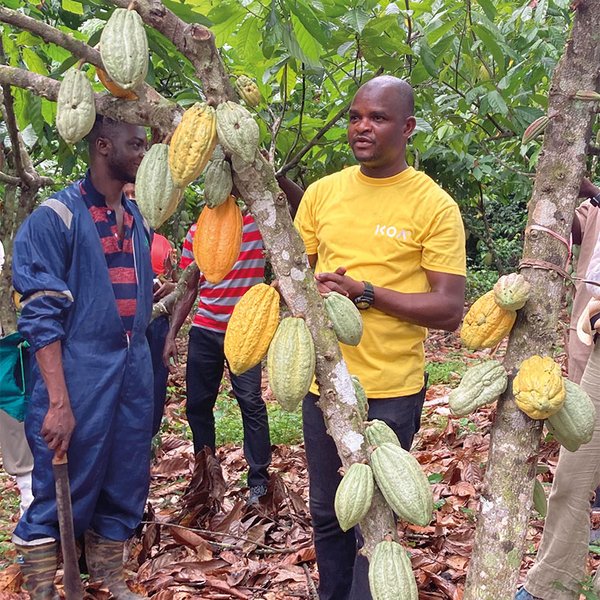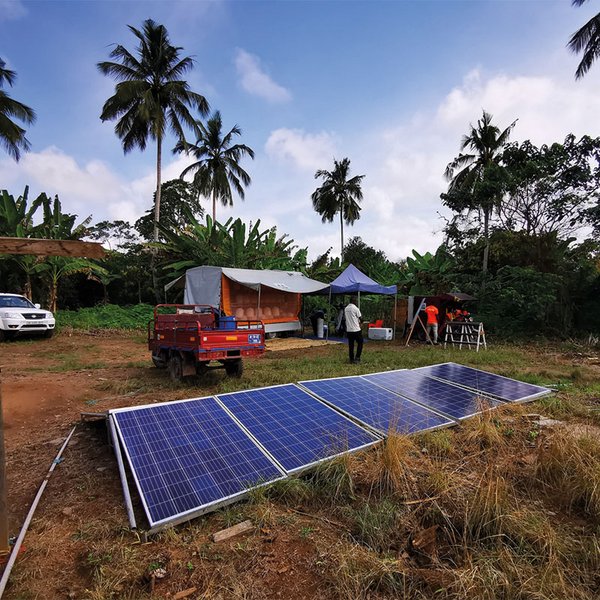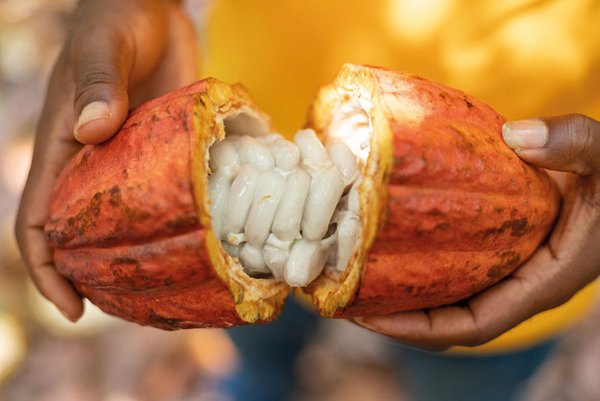 Download this article in magazine layout
Download this article in magazine layout
- Share this article
- Subscribe to our newsletter
Turning cocoa waste into a high-quality product for confectionery
The West African countries of Ghana and Cote d’Ivoire grow roughly 64 per cent of the cocoa beans used for global chocolate production. The climatic conditions in this region of West Africa are ideal for cocoa: not too much sun and not too much rain, as well as sufficient rainforest cover below which the cocoa trees can thrive. Ghana is the world’s second largest exporter of cocoa after Côte d’Ivoire. The cocoa beans are mostly grown by smallholder farmers. Ageing plantations, viral diseases of the cocoa trees and climate change-induced increasing droughts make life difficult for the farmers. And it is not an easy life to begin with, for on average, the smallholder farmers earn only about two US dollars a day.
In order to better compete on the world market, the Ghanaian government, through the Ghana Cocoa Board, retains the monopoly and sets producer and sales prices. The Cocoa Board provides the smallholder farmers with a level of security because it pays fixed prices for the harvest and supplies them with fresh trees as well as fertiliser and pesticides. But for every Euro that European consumers pay on average for a 100g bar of chocolate, the smallholder farmers receive only 7 cents. Four cents go to the Cocoa Board, 2 cents to transport companies, 8 cents to mills, 35 cents to chocolate manufacturers and 44 cents to retailers.
Cocoa farming is a hardscrabble existence. The farming families usually live remotely in the rainforest, often without access to public road networks, which means that they have extremely limited access to markets and children can only attend school with great difficulty. Moreover, cocoa cultivation brings with it environmental hazards. When the beans are harvested, crop residues accumulate, such as the husks and the pulp that coats the beans. The pulp seeps into the soil, negatively impacting soil quality. The husks rot, releasing CO2 in the process.
Designing new products – from idea to implementation
A young team from Ghana and Germany realised that these adverse processes can not only be avoided but that new products can be developed from the unused parts of the cocoa fruit, which can yield additional income for the farmers. The idea was realised in July 2017 with the establishment of the start-up Koa in Zurich, Switzerland (see Box). One year later, the subsidiary Koa Impact Ltd. was established in the Ghanaian capital Accra. The idea was to process the cocoa pulp into a variety of raw materials for quality products in the confectionary industry and catering. The first production plant opened in September 2019, in Akrofuom in the Ashanti Region. In August 2023, a second factory opened in Achiase in the Eastern Region. As of August 2023, Koa had 100 employees – 82 in Ghana and 18 in Zurich.
How it all started
Originally, Anian Schreiber and Benjamin Kuschnik, who for several years had worked for the Chinese solar energy company Yingli in Africa, wanted to set up their own enterprise selling solar home systems in West African countries. They saw cocoa farmers in Ghana as potential clients, but soon realised that these smallholder farmers, who usually lived in the tropical rainforest, often without road access, did not have the means to buy such systems. It was Anian Schreiber who during his visits to the villages observed how the cocoa fruit was harvested and how the beans, which are surrounded by a gelatinous pulp, were detached from the husks and placed onto a mat to drain. The husks were thrown onto a heap to rot at a distance from the cocoa trees. Schreiber also saw some of the pulp dripping into the soil. He realised that this juice from the pulp was extremely tasty. So he considered that it might be a good idea to put this waste product from the cocoa bean harvest to good use and at the same time create an additional income for the cocoa farmers.
Together with Swiss and Ghanaian universities, Koa developed the solar-powered “Community Mobile Processing Unit”, or CMPU. It allows for the fruit pulp to be collected and pressed directly on site, on the local farms. The farmers can follow the extraction process in the press to be sure that the beans are not damaged and that they get back the very beans they have grown. The pulp is then processed into juice and juice concentrates in the nearby factory. There are two crucial aspects to this process: Firstly, the pulp has to be processed immediately post-harvest, as it starts to ferment quickly in the hot and humid climate. Secondly, the process used to separate the pulp from the beans must be particularly gentle. It has to guarantee that around 30 per cent of the pulp remains on the beans, as this is crucial for the cocoa beans’ fermentation and determines their ultimate quality.

Agricultural ecologist Abubakar heads the extension programmes in Achiase. Photo: Angelika Wilcke
Koa’s fruit juice is used either in its “pure” form or concentrated. For example, a Dutch start-up called “Kumasi Drinks” has brought various tropical fruit juice drinks based on “Koa pure” onto the market. Bulk purchasers from the chocolate industry and confectioners, also in Switzerland (Lindt, Sprüngli, Felchlin), France (Valrhona) and Luxembourg (Oberweis Confiserie) use the juice, processed into powder or syrup, for “refined” sweetening of their chocolates and cakes, small tarts, desserts, etc. The fine cocoa aroma of the Koa products appeals to chocolate manufacturers, and they can advertise that their chocolates have been produced “vegan” and sustainably.
Decent prices and training for farmers
As of August 2023, Koa worked with some 5,000 smallholder farmers (2,200 in Akrofuom and roughly 2,800 in Achiase). The Akrofuom plant produces around 300 tonnes of cocoa fruit juice annually. Upon selling the pulp, farmers immediately receive 16 Ghanaian Cedi (GHS) per bucket of pulp via mobile banking, which amounts to 3,520 GHS per tonne (12 Cedi equals 1 Euro). This means that farmers have extra money at hand immediately post-harvest and do not have to wait for two to three months until they receive their payments for the cocoa beans via the Cocoa Board. For 2023, this translates into an additional income of 307 USD per tonne of pulp for the farmers. The partner farmers receive additional training in the management of cocoa trees, in pollination techniques to improve tree productivity and in soil improvement with organic fertilisers, for which the cocoa husks can be utilised among other materials.

The mobile pressing unit is powered with solar energy. Photo: KOA
An additional goal the company aims to achieve is to get to a CO2-free cocoa economy. The start-up is currently working on the development of a process with which the cocoa fruit husks can be converted into biochar in a closed pyrolysis process. So far these have been rotting into the ground unused, releasing CO2 and also acting as hosts for fungal and other crop diseases. The smallholder farmers of West Africa are being challenged by decreasing soil fertility and the risk of longer drought periods. The application of biochar could increase soil fertility and enhance the cocoa farmers’ capacity to adapt to climate change. In January 2023, the company launched a pilot project to this end. The aim was to determine the availability of cocoa pod husks and their conversion factor into biochar. Encouraged by the results, Koa is now preparing the launch of a bigger pilot project in order to determine the feasibility of the business model over the next two years. The pilot project is supported by a grant from the Swiss government (SECO) under the Swiss Platform for Sustainable Cocoa.
Both the Community Mobile Processing Unit and the two processing plants in Akrofuom and Achiase are powered by solar energy. The vehicles used to transport the buckets of pulp from the farms to the factory and back to the farms have so far run on conventional fuel. Since February 2023, initial trials have been underway to test a solar-powered tricycle which is being developed by a small start-up in Germany called AMC – African Motor Company. These tricycles are made of robust parts and can easily be assembled in different locations, including rural areas of Africa. The vehicles can transport a load of up to one tonne up to 100 kilometres, even in rough terrain. Koa aims to replace its Chinese tricycles with these solar-powered vehicles. To this end, a workshop is currently being built on the factory premises in Achiase. The first locally built small e-transporter is to be assembled there by the end of 2023.
The future of cocoa farming − a win-win-win story?
“Improving income for cocoa farmers, boosting economic growth, creating more jobs, aiming for less or even zero food waste, making use of solar energy” − this is the company’s vision. With the opening of the processing plant in Achiase, roughly a four-hour drive from the capital Accra, Koa is a big step closer to realising this vision. In the near future, the start-up aims to increase the production of cocoa fruit juice tenfold, i.e. from 300 tonnes so far in Arkofuom to 3,000 tonnes per year in Achiase and Akrofuom. It is envisaged that in the Achiase region, 10,000 cocoa farmers will become involved in the project. The training measures are to be passed on in a snowball system from Koa staff to the partner farmers, who in turn will be enabled to train the latter in their communities.
What began with a compelling idea six years ago has developed into a sustainable development concept benefiting all: the cocoa farmers and their families, whose living conditions are improved by the additional income, the environment through an improved carbon footprint and the sustainable cultivation of cocoa trees, Koa’s investors, and last but not least the chocolate industry, which has committed to making its own contribution to the Sustainable Development Goals. And then of course, at the very end of the supply chain, there are the end consumers who can enjoy sustainably produced confectionery.
Angelika Wilcke is an editor of Rural 21.
Contact: a.wilcke@dlg.org





Add a comment
Be the First to Comment